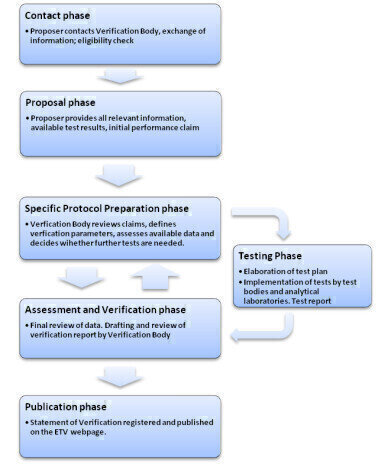Water/Wastewater
EU Environmental Technology Verification (ETV) Pilot Programme
Dec 05 2012
A case study by CSA-Sira.
The ETV framework has been established by the European Commission (EC) for new, innovative technologies, which by definition do not have any standards to be evaluated against. The voluntary pilot programme is split into three technology areas:
- Water treatment and monitoring
- Materials, waste and resources
- Energy technologies
Below is an extract from the General Verification Protocol (GVP)1, the technical reference document for ETV, explaining the impetus of the ETV programme:
Europe and the rest of the world are confronted with urgent environmental challenges such as climate change, the unsustainable use of resources and loss of biodiversity. Environmental technologies have a role to play in addressing these challenges and, at the same time, can contribute positively to competitiveness and growth.
The objective of Environmental Technology Verification (ETV) is to promote innovative environmental technologies by providing developers, manufacturers and investors access to third-party performance verification.
As shown in the flow chart, in order for a new technology to be verified, evidence, in the form of valid test data, is needed to demonstrate the performance. If existing data of good quality is available it will be reviewed by the Verification Body for acceptance, reducing time and costs for the proposer.
Successful ETV applications result in a Verification Statement that is published on the EU ETV webpage. The information contained in the Statement of Verification summarises the actual performance of the verified technology, including the results of the tests performed.
The programme is underpinned by quality assurance, requiring Verification Bodies to be accredited to ISO 17020 for the specific technology areas listed above. This ensures a level playing field across Europe. Additionally; Technical working groups, one per technology area or sub-area, will be established in order to harmonise the implementation of ETV procedures by Verification Bodies in the different technology areas and in the different participating countries, and ensure the same level of quality of verification results, in particular Statements of Verification.1
Relationship with MCERTS
MCERTS is the Environment Agency’s (EA) Monitoring Certification Scheme, which includes performance standards for environmental monitoring equipment. The EU ETV programme is not a replacement or duplication of the current MCERTS scheme in place in the UK, which is widely accepted internationally. The ETV programme is for new, innovative technologies where there are no existing standards to test or validate against.
Work conducted under the ETV programme could be used as a basis to develop MCERTS standards further in the future. With support from industry, the EA are willing to review the need for new standards and develop them where required. Examples of this can be seen from the MCERTS standards for Indicative Particulate Monitoring Systems and Environmental Data Acquisition Software, which have been published as a result of support and work from manufacturers.
Current Status of the Programme
The application process is underway for Verification Bodies wishing to become accredited for ETV approvals. A list of applicants can be seen on the webpage. CSA-Sira has applied to UKAS for accreditation to become a Verification Body for the ETV programme for the technical areas Water treatment and monitoring and Energy technologies.
Benefits of ETV
ETV offers advantages to all stakeholders involved:
- It provides the proposer / developer of new technology a third party approval enabling them to enter new markets and promote their technology.
- Users of new technology can be assured that it has been independently tested, and performance claims that are made can be trusted.
- It will also enable regulators to trust new innovative methods that may have previously been disregarded as unreliable.
If ETV is embraced by industry, it will result in new, innovative methods being used for a number of applications and methods. The net result will be a better understanding and protection of our environment through the use of new technology.
For more information on the ETV please see the links below, or contact Emily Jarvis at CSA-Sira:
CSA-Sira; Tel: Emily Jarvis +44 (0)1244 670 920
Email: Emily.Jarvis@siracertification.com / info@siracertification.com
Web: www.siraenvironmental.com
References:
1. General Verification Protocol, Version 1.0 – December 15th, 2011 http://ec.europa.eu/environment/etv/pdf/gvp.pdf
Useful Links:
EU ETV homepage: http://j.mp/Yp24DL
Proposed Verification Bodies can be seen on: http://ec.europa.eu/environment/etv/etv_preprog.htm
Information on MNCERTS: www.mcerts.net
Digital Edition
IET 34.2 March 2024
April 2024
Gas Detection - Biogas batch fermentation system for laboratory use with automatic gas analysis in real time Water/Wastewater - Upcycling sensors for sustainable nature management - Prist...
View all digital editions
Events
Apr 22 2024 Hannover, Germany
Apr 22 2024 Marrakech, Morroco
Apr 23 2024 Kuala Lumpur, Malaysia
Apr 23 2024 Kintex, South Korea
Apr 23 2024 Edmonton, AB, Canada



















